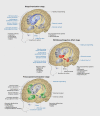Individual differences in the neuropsychopathology of addiction
- PMID: 29302219
- PMCID: PMC5741105
- DOI: 10.31887/DCNS.2017.19.3/gkoob
Individual differences in the neuropsychopathology of addiction
Abstract
Drug addiction or substance-use disorder is a chronically relapsing disorder that progresses through binge/intoxication, withdrawal/negative affect and preoccupation/anticipation stages. These stages represent diverse neurobiological mechanisms that are differentially involved in the transition from recreational to compulsive drug use and from positive to negative reinforcement. The progression from recreational to compulsive substance use is associated with downregulation of the brain reward systems and upregulation of the brain stress systems. Individual differences in the neurobiological systems that underlie the processing of reward, incentive salience, habits, stress, pain, and executive function may explain (i) the vulnerability to substance-use disorder; (ii) the diversity of emotional, motivational, and cognitive profiles of individuals with substance-use disorders; and (iii) heterogeneous responses to cognitive and pharmacological treatments. Characterization of the neuropsychological mechanisms that underlie individual differences in addiction-like behaviors is the key to understanding the mechanisms of addiction and development of personalized pharmacotherapy.
La adicción a drogas o el trastorno por uso de sustancias es un trastorno crónico con recaídas que progresa a través de las etapas de compulsión / intoxicación, abstinencia/afecto negativo y preocupación/anticipación. Estas etapas representan diversos mecanismos neurobiológicos que participan diferenciadamente en la transición desde el uso recreacional al uso compulsivo de la droga y desde un refuerzo positivo a uno negativo. La progresión, desde un uso recreacional de la sustancia a uno compulsivo, está asociada con una regulación negativa de los sistemas cerebrales de recompensa y una regulación positiva de los sistemas cerebrales del estrés. Las diferencias individuales en los sistemas neurobiológicos que están a la base del procesamiento de la recompensa, del aumento del incentivo, de los hábitos, del estrés, del dolor, y de la función ejecutiva pueden explicar: 1) la vulnerabilidad al trastorno por uso de sustancias, 2) la diversidad de los perfiles emocionales, motivacionales y cognitivos de los sujetos con trastornos por uso de sustancias y 3) las respuestas heterogéneas a los tratamientos cognitivos y farmacológicos. La clave para comprender los mecanismos de la adicción y el desarrollo de una farmacoterapia personalizada es la caracterización de los mecanismos neuropsicológicos que subyacen a las diferencias individuales en las conductas adictivas.
L'addiction aux drogues ou le trouble de l'usage d'une substance est une maladie à rechutes chroniques qui évolue par des étapes de compulsion/intoxication, sevrage/effet négatif et préoccupation/anticipation. Ces étapes représentent des mécanismes neurobiologiques variés différemment impliqués dans la transition allant de l'usage récréatif à l'usage compulsif d'une drogue et du renforcement positif au renforcement negatif. Le passage de l'usage récréatif à l'usage compulsif d'une substance est associé à une régulation négative des systèmes cérébraux de récompense et à une régulation positive des systèmes cérébraux de stress. Des différences individuelles dans les systèmes neurobiologiques sous-tendant le processus de récompense, de saillance incitative, d'habitudes, de stress, de douleur et de fonction exécutive peuvent expliquer 1) la vulnérabilité aux troubles liés à l'usage de substances ; 2) la diversité des profits émotionnels, motivationnels et cognitifs des individus souffrant de troubles liés à l'usage de substances et 3) les réponses hétérogènes aux traitements cognitifs et pharmacologiques. La clé de la compréhension des mécanismes d'addiction et du développement de traitements pharmacologiques personnalisés est la caractérisation des mécanismes neuropsychologiques sous-tendant les différences individuelles dans les comportements addictifs.
Keywords: alcohol; compulsivity; drug; nicotine; stress.
Figures



References
-
- Koob GF., Le Moal M. Drug abuse: heclonic homeostaticdysregulation. Science. 1997;278(5335):52–58. - PubMed
-
- Koob GF., Le Moal M. Drug addiction, dysregulation of reward, and allostasis. Neuropsychopharmacology. 2001;24(2):97–129. - PubMed
-
- Koob GF., Le Moal M. Addiction and the brain antireward system. Annu Rev Psychol. 2008;59:29–53. - PubMed
